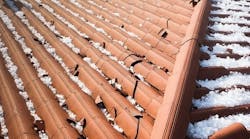A building is resilient if it can withstand extreme weather events while remaining habitable without power, at least for a short period until power is restored. A building’s roof system is an integral component of resilience. If a roof is damaged or blows off, it’s likely the building will be unusable or uninhabitable until the roof is repaired or replaced. This is true for buildings of all heights and occupancies.
The most important elements of a resilient roof system are wind resistance, impact resistance, insulation, roof color, daylighting and rooftop energy production.
Wind Resistance
First and foremost, resilient roofs should withstand high winds. While building codes have become more stringent on wind design of roofs, designing for higher wind speeds than codes require (e.g., +10, +20 mph) will certainly provide greater protection against blow-offs.
From decades of post-event investigation, the roofing industry knows that most wind-related damage begins at the perimeters and corners. Enhancing the edge metal details with thicker metal and higher fastener density increases their wind resistance. For example, using 22-gauge metal instead of 24-gauge metal and installing fasteners 8 inches apart rather than 12 inches can provide cost-effective protection for the long term.
In addition to a well-designed perimeter edge or parapet, a “peel-restraint bar” can be installed as a secondary measure. The bar can be a continuous piece of metal (e.g., a termination bar) located 2 to 3 feet from a building’s perimeter. It’s installed above the membrane, fastened directly to the structure, then covered with a membrane to keep it weather-tight. This is a very effective preventive measure that can be implemented on existing roofs.
Impact Resistance
Depending on the weather event, impact resistance can mean resistance to hail, debris or rooftop equipment. A tough membrane with a durable cover board between the insulation layer and membrane can provide much improved impact-resistance. High-density polyiso cover boards provide terrific resistance to impacts from hail because they absorb the impact and do not crush. In hail-prone regions, an appropriate cover board is essential for a resilient roof system.
Where large hail is frequent, cementitious pavers above the roof membrane may be needed. Pavers can be added to existing roofs, but their weight can be significant. Check the capacity of the roof structure before adding pavers to an existing roof.
Although often overlooked, rooftop equipment — from exhaust vents to HVAC units — can be tossed about and overturned during high winds, damaging a roof and allowing water to enter a building. Once rain is freely entering a building, it is no longer habitable and thus no longer resilient. Fasteners and tethers can be added to equipment at any time, not just during new construction or reroofing.
Insulation and Roof Color
Roof insulation and roof color play an important role in keeping occupants comfortable and productive in a resilient building. A high R-value roof means less transfer of heat into and out of a building, allowing it to maintain a more suitable interior temperature if the power is out.
[Related: 3 Vital Roles of Roofing Insulation]
Pairing a high-R roof with operable windows that allow natural ventilation can contribute to occupant comfort. Also, reflective roof surfaces (e.g., a white membrane or white coating) reduce a large percentage of the potential solar gain, resulting in less heat transfer into a roof. The greater the roof-to-wall ratio, the more important the roof’s overall thermal effectiveness becomes.
Daylighting
When the power is out, rooftop daylighting systems can provide adequate daylight to keep a building functional. However, it’s important to balance the trade-off between daylighting and a reduction in the roof’s R-value. Also ensure that daylighting systems are impact resistant.
[On topic: 3 Tips for Daylighting Integration]
Rooftop Energy Production
For longer-term building resiliency, energy production from solar panels can be added to a rooftop. During a power outage, solar energy can operate key components of a building. However, most PV systems rely on the grid and will not provide energy during a blackout. When power is out, solar panels require energy storage from batteries to operate and provide electricity. Consider the cost to a grocery store when loss of power means throwing away aisles of refrigerated and frozen food. A battery-backup PV system might well be worth the cost.
Although a true resilient roof system would incorporate all the elements described above, keep in mind that most are relatively simple upgrades to the minimum performance requirements of a roof. Building owners have options to increase their roof’s resilience.
James R. Kirby, AIA, is the Building and Roofing Science Architect for GAF on the East Coast. Get more information at GAF.


